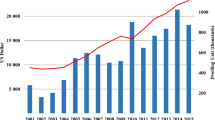Abstract
Over the past several decades, in Canada as elsewhere, governments have sought to provide decent, affordable housing for every household. However, viewed in aggregate, the size and extent of the affordability problem in Canada may well have worsened. This paper argues that changes in housing affordability are linked to the changing pace and character of household formation and that household formation has been responsive to a variety of public policies generally, and to housing programs in particular. Over the last four decades or so, changes in household formation have reflected policy inducements, price movements and income growth, and the substantial elasticity of demand for separate living arrangements. Even worsening indicators of affordability may actually indicate the success of modern housing policy, although this raises questions about the appropriateness of the measures, about the goals of housing programs, and about the ultimate costs of eliminating the affordability problem.
Similar content being viewed by others
References
J.C. Beresford and A.M. Rivlin (1966). Privacy, poverty, and old age. Demography, 3. 247–258.
D.S Brady (1958). Income and consumption: individual incomes and the structure of consumer units. American Economic Review, 48 (supplement). 269–278.
O. J. Firestone (1951). Residential Real Estate in Canada. Toronto, University of Toronto Press.
J.D. Hulchanski (1988). New Forms of Owning and renting. Mimeographed paper prepared for the “Housing Progress in Canada Since 1945” monograph currently being completed for Canada Mortgage and Housing Corporation. Vancouver, School of Community Planning, University of British Columbia.
Federal/Provincial Task on the Supply and Price of Serviced Residential Land (1978). Volume One: Chairman's Report. David B. Greenspan, Chairman.
F.H. Leacy, ed. (1983). Historical Statistics of Canada. Second Edition. Ottawa, Statistics Canada.
J.R. Miron (1984). Housing Affordability and Willingness to Pay. Research Paper 154. Toronto: Centre for Urban and Community Studies, University of Toronto.
J.R. Miron (1988). Housing in Postwar Canada: Demographic Change, Household Formation, and Housing Demand. Kingston and Montréal: McGill-Queen's University Press.
Statistics Canada (1969). Incomes of Nonfarm Families and Individuals in Canada: Selected Years, 1951–1965. Catalogue 13–529. Ottawa, Statistics Canada.
Statistics Canada (1987). Income Distributions by Size in Canada: 1986. Catalogue 13–207. Ottawa, Statistics Canada.
S.T. Wargon (1979). Canadian Households and Families. Cat 99–753E. Ottawa, Statistics Canada.
Author information
Authors and Affiliations
Rights and permissions
About this article
Cite this article
Miron, J.R. Household formation, affordability, and housing policy. Popul Res Policy Rev 8, 55–77 (1989). https://doi.org/10.1007/BF00124280
Issue Date:
DOI: https://doi.org/10.1007/BF00124280




